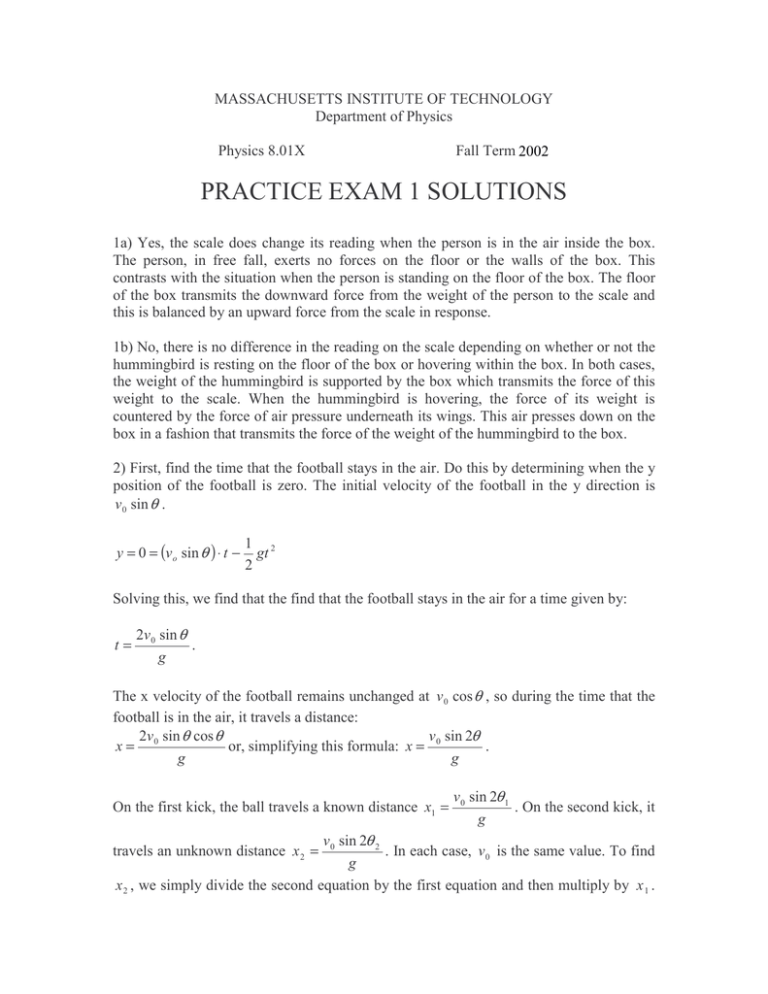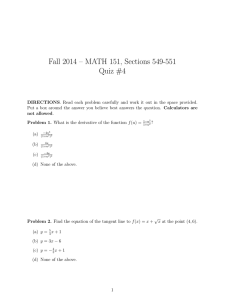Document 13605717
advertisement

MASSACHUSETTS INSTITUTE OF TECHNOLOGY Department of Physics Physics 8.01X Fall Term 2002 PRACTICE EXAM 1 SOLUTIONS 1a) Yes, the scale does change its reading when the person is in the air inside the box. The person, in free fall, exerts no forces on the floor or the walls of the box. This contrasts with the situation when the person is standing on the floor of the box. The floor of the box transmits the downward force from the weight of the person to the scale and this is balanced by an upward force from the scale in response. 1b) No, there is no difference in the reading on the scale depending on whether or not the hummingbird is resting on the floor of the box or hovering within the box. In both cases, the weight of the hummingbird is supported by the box which transmits the force of this weight to the scale. When the hummingbird is hovering, the force of its weight is countered by the force of air pressure underneath its wings. This air presses down on the box in a fashion that transmits the force of the weight of the hummingbird to the box. 2) First, find the time that the football stays in the air. Do this by determining when the y position of the football is zero. The initial velocity of the football in the y direction is v 0 sin θ . y = 0 = (v o sin θ ) ⋅ t − 1 2 gt 2 Solving this, we find that the find that the football stays in the air for a time given by: t= 2v 0 sin θ . g The x velocity of the football remains unchanged at v 0 cos θ , so during the time that the football is in the air, it travels a distance: v sin 2θ 2v sin θ cos θ x= 0 or, simplifying this formula: x = 0 . g g On the first kick, the ball travels a known distance x1 = v 0 sin 2θ 1 . On the second kick, it g v 0 sin 2θ 2 . In each case, v 0 is the same value. To find g x 2 , we simply divide the second equation by the first equation and then multiply by x 1 . travels an unknown distance x 2 = sin 2θ 2 . We know all the quantities on the right hand side of this sin 2θ 1 equation. Plugging in the numbers, we find that x 2 =69.2 yards. This gives: x 2 = x1 3a) At small times we can expand the exponent in a Taylor series. The first four terms of 2 3 1§ t · 1§ t · t t this series are: 1 − << 1, and we + ¨ ¸ + ..... . At small times, ¸ − ¨ 6 © RC ¹ RC RC 2 © RC ¹ can safely ignore all but the first two terms. § t · Therefore at small times, equation )1) becomes: Vcap (t ) ≈ Vcell ¨ − ¸ . Flipping this © RC ¹ RC around, we find that t ≈ Vcap (t ) . Vcell 3b) For this, we need t = 0.2 . Plugging in the numbers gives t= 4 seconds. RC RC Vcap (t ) , we can determine the times for falling each of the Vcell 1 distances. The formula y = gt 2 tells us that if we plot the distance of each fall as a 2 1 function square of the time for the fall, the slope on the plot will be g . For the three 2 distances, we find squared times of 0.0524 sec2, 0.0267 sec2, and 0.0139 sec2 for the three heights. Plotting these points and fitting the best straight line through these points (the line must also go through zero, because we expect that for zero height it takes zero time to fall!), we get the plot below. 3c) Using the equation t ≈ falling heights vs. time squared The slope of the line drawn is about 0.495 meters/second2. Our measured value for g is 9.81 m/s2. 0.3 height (meters) 0.25 0.2 0.15 0.1 0.05 0 0 0.01 0.02 0.03 0.04 time squared (seconds squared) 0.05 0.06




